How to write evergreen content that is well-researched – In the realm of content creation, evergreen content stands tall as a beacon of enduring relevance. It transcends the constraints of time, providing valuable insights and information that remain perpetually fresh and engaging. This comprehensive guide delves into the art of crafting well-researched evergreen content, empowering you to create content that resonates with audiences long after its initial publication.
Through a meticulous exploration of best practices, from conducting thorough research to structuring and organizing content effectively, this guide equips you with the knowledge and skills to produce evergreen content that captivates readers, establishes authority, and drives long-term engagement.
Understanding Evergreen Content
Evergreen content refers to timeless and consistently relevant information that remains valuable and engaging over an extended period. Unlike news or trend-based pieces, evergreen content focuses on fundamental concepts, principles, or topics that are not subject to rapid changes or expiration dates.Characteristics of evergreen content include:
Comprehensiveness
Provides in-depth coverage of a topic, addressing various aspects and providing a holistic understanding.
Keep up-to-date on the latest news and current events by visiting The Motiv. Our comprehensive coverage of global affairs, politics, and entertainment will keep you informed and engaged. Additionally, discover our insightful articles on creating evergreen contentthat will continue to resonate with your audience long after its initial publication.
Accuracy
Based on well-researched and verifiable sources, ensuring reliability and credibility.
Clarity
Written in a clear and accessible style, making it easy for readers to understand and retain the information.
Value
Offers practical insights, actionable advice, or valuable knowledge that benefits readers.Examples of topics that lend themselves to evergreen content include:
- How-to guides and tutorials on fundamental skills or processes
- Explanations of scientific concepts or principles
- Historical overviews and analyses
- Comprehensive reviews of industries or markets
- Case studies and success stories
Benefits of creating evergreen content:
Long-term value
In today’s rapidly evolving media landscape, creating content that stands the test of time is crucial. Evergreen contentprovides lasting value and remains relevant over an extended period, ensuring that your audience continues to engage with your work long after its initial publication.
By understanding the principles of evergreen content creation, you can craft pieces that resonate with readers, establish your authority, and drive consistent traffic to your website.
Evergreen content continues to attract readers and generate traffic over time, providing a steady stream of engagement.
benefits
Search engines favor high-quality, informative content that remains relevant, leading to improved rankings and organic visibility.
Brand building
Evergreen content establishes your website or blog as a trusted source of information, enhancing your credibility and authority in your niche.
Conducting Thorough Research
Thorough research is crucial for creating evergreen content that stands the test of time. By gathering relevant and credible information, you can ensure that your content remains accurate and authoritative for years to come.
Best Practices for Gathering Relevant and Credible Information
- Identify your target audience:Determine who you are writing for and what information they are most interested in.
- Use a variety of sources:Consult a mix of books, journals, websites, and databases to gather a comprehensive understanding of your topic.
- Check the credibility of sources:Evaluate the author’s expertise, the publisher’s reputation, and the currency of the information.
Identifying and Accessing Authoritative Sources
Authoritative sources are those that are written by experts in the field and have been peer-reviewed or published by reputable organizations. Some examples of authoritative sources include:
- Scholarly journals
- Government publications
- University websites
Techniques for Evaluating the Quality and Accuracy of Information
Once you have gathered information from a variety of sources, it is important to evaluate its quality and accuracy. Consider the following factors:
- Currency:Is the information up-to-date and relevant to the topic?
- Accuracy:Is the information factual and supported by evidence?
- Objectivity:Is the information presented without bias or personal opinion?
Structuring and Organizing Content
Structuring and organizing your evergreen content is crucial for both search engine optimization () and reader engagement. An effectively structured article will be easy to navigate, understand, and share.To create a well-structured article, start by outlining your main points. Each point should be a separate section or subsection, with subheadings to help readers skim the content and find the information they need quickly.
Use subheadings, bullet points, and other formatting elements to improve readability and break up the text.
Designing a Logical Flow of Information
The logical flow of information is essential for keeping readers engaged and helping them understand your content. Start with a strong introduction that grabs attention and provides a clear overview of the topic. Then, use transitions to guide readers through the article, connecting each section and subsection smoothly.
Finally, end with a strong conclusion that summarizes the main points and leaves readers with a clear understanding of the topic.
Crafting Compelling and Engaging Content
Creating content that is not only informative but also engaging and compelling is crucial for capturing and retaining readers’ attention. Clear and concise prose, active voice, strong verbs, and vivid language are essential elements in achieving this goal.
Writing Clear and Concise Prose
- Use short, simple sentences that are easy to read and understand.
- Avoid jargon and technical terms that may be unfamiliar to your audience.
- Use specific examples and anecdotes to illustrate your points.
- Break up long paragraphs into smaller chunks to improve readability.
Active Voice and Strong Verbs
- Use active voice whenever possible, as it makes your writing more direct and engaging.
- Choose strong verbs that convey action and avoid passive language.
- For example, instead of writing “The report was written by John,” write “John wrote the report.”
Vivid Language
- Use sensory details, metaphors, and similes to create vivid imagery and make your writing more memorable.
- Appeal to the reader’s senses by using descriptive language that evokes sight, sound, smell, taste, and touch.
- For example, instead of writing “The sunset was beautiful,” write “The sun dipped below the horizon, casting a golden glow across the sky.”
Incorporating Visuals and Multimedia: How To Write Evergreen Content That Is Well-researched

Visuals and multimedia play a crucial role in enhancing the effectiveness of evergreen content. They break up text-heavy sections, making content more engaging and easier to consume. By incorporating visuals, you can illustrate complex concepts, provide context, and evoke emotions in your audience.
Selecting and Using Visuals
When selecting images, videos, and other multimedia, consider their relevance to the topic and their ability to convey the message effectively. High-quality visuals that are visually appealing and well-integrated into the content will enhance the user experience.
Stay informed and up-to-date with the latest news and current events by visiting The Motiv, your trusted source for reliable and comprehensive daily news coverage. Our team of experienced journalists provides in-depth analysis, breaking news, and insightful commentary on a wide range of topics, ensuring that you stay informed and connected to the world around you.
Optimizing Visuals for Web Use
For optimal web performance, it’s essential to optimize visuals by reducing file sizes without compromising quality. Use image compression tools to reduce file sizes while maintaining clarity. Consider using responsive images that adjust their size based on the screen size, ensuring a seamless viewing experience across devices.
Promoting and Distributing Content
Evergreen content remains valuable over time, but it requires promotion and distribution to reach its target audience. Effective strategies include leveraging social media platforms, email marketing campaigns, and other relevant channels. Building backlinks and establishing authority enhance credibility and visibility.
Repurposing evergreen content into various formats, such as videos, infographics, or podcasts, expands its reach and engages diverse audiences.
Social Media Promotion, How to write evergreen content that is well-researched
Social media platforms offer vast opportunities to promote evergreen content. Share valuable insights, create engaging visuals, and utilize relevant hashtags to captivate followers. Run targeted social media ads to reach specific audiences based on demographics, interests, and behaviors. Encourage user engagement by fostering discussions, hosting Q&A sessions, and running contests or giveaways related to the content.
Email Marketing
Email marketing remains an effective channel for promoting evergreen content. Segment your email list based on subscriber interests and preferences. Craft compelling subject lines and email body copy that highlights the value and relevance of the content. Include clear call-to-actions to encourage readers to click through to your website or landing page.
Consider using email automation to deliver evergreen content at optimal times.
Building Backlinks and Authority
Backlinks from reputable websites signal to search engines that your content is valuable and trustworthy. Reach out to industry experts, bloggers, and influencers to request backlinks to your evergreen content. Create high-quality content that other websites will naturally want to link to.
Participate in online forums and discussions to establish your expertise and build relationships that can lead to backlinks.
Repurposing Evergreen Content
Repurposing evergreen content into different formats extends its reach and engages diverse audiences. Transform written content into videos, infographics, podcasts, or presentations. Create shorter snippets for social media posts or micro-content for email campaigns. Consider translating your content into multiple languages to cater to a global audience.
By repurposing evergreen content, you maximize its impact and increase its chances of reaching a wider audience.
Maintaining and Updating Content

Evergreen content is designed to remain relevant and valuable over time, but it’s essential to regularly review and update it to ensure its accuracy and freshness.
Outdated information can erode the credibility of your content and mislead readers. By proactively identifying and revising outdated sections, you can maintain the integrity and relevance of your evergreen pieces.
Updating Strategies
- Establish a regular review schedule:Set a specific frequency (e.g., quarterly, annually) for reviewing your evergreen content.
- Monitor industry trends:Stay abreast of industry developments and emerging trends that may impact the accuracy of your content.
- Seek feedback from readers:Encourage readers to provide feedback on the accuracy and relevance of your content. This feedback can help identify areas that need updating.
- Use analytics to track performance:Analyze metrics such as traffic, engagement, and conversions to identify content that may need refreshing.
Final Summary
Mastering the art of evergreen content creation empowers you to build a robust content library that stands the test of time. By adhering to the principles Artikeld in this guide, you can create content that consistently attracts, informs, and delights your audience, solidifying your position as a trusted source of valuable information.